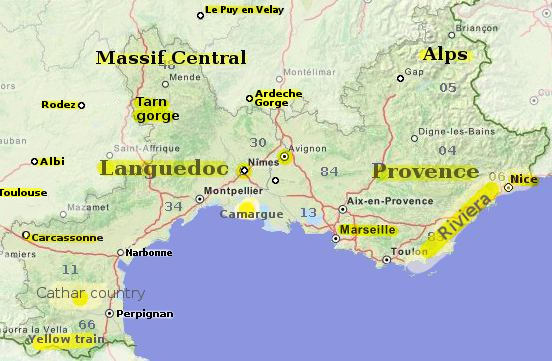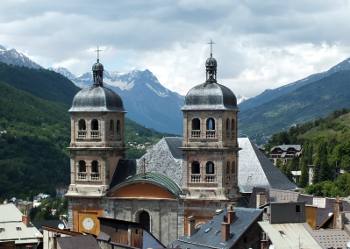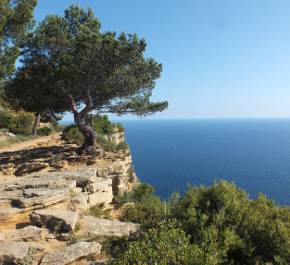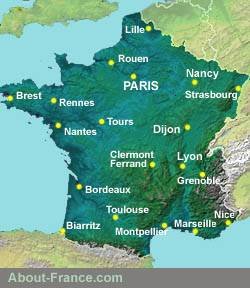
The South of France
An inside guide to Mediterranean France - Languedoc and Provence
- Explore France ►
- Essential pages
- Travel in France
- Where to go
- What to see and do
About-France.com
- the connoisseur's guide to France
The south of France from the Riviera to the Pyrenees
Click any yellowed area on the map to open up a more detailed page or pages.
► See also; city guides: Nice Marseilles Nimes Aix-en-Provence
| Page index | Area overview | Main tourist attractions | Main cities |

The area that makes up what the French refer to as "le Midi", is generally speaking the most popular tourist region in France, and needs little introduction. It consists of the French Mediterranean coastline and its hinterland, from the Italian to the Spanish borders, and is made up of two French regions, PACA or Provence-Alpes-Côte d'Azur to the east of the Rhone, and Languedoc Roussillon to the west of the Rhone.
. The coastal region is very busy in Summer, and travelling to the south of France by car on a summer Saturday can be a nightmare experience; but the region has masses to offer, in terms of climate, history, and landscape.
The French Riviera ("la Côte d'Azur") is a small part of the south of France, the thin coastal strip from around Cassis (east of Marseille) in the west to the Italian border in the east. It is a coastline that gets very crowded in summer, though on account of the rocky coastline, there are still some quiet and peaceful spots to be found, for instance around Saint-Raphaël.
 Briançon, in
the southern Alps
Briançon, in
the southern Alps  Beach
in the Languedoc
Beach
in the LanguedocThe Languedoc region is the area to the west of the Rhone; it is known on the one hand for its long sandy beaches, and onthe other for its huge vineyards and "garrigue", arid rocky Mediteranean hills with their vegetation of scrub, aromatic bushes and occasional fields. The most historic city is Nimes with its superb Roman remains. High Languedoc includes the southern flank of the Massif Central mountains, a dry mountainous area a bit different to upper Provence, and cut through by deep valleys such as that of the Tarn.

Nimes' Maison Carrée - a finely preserved Roman temple
The southern end on the Languedoc includes the eastern end of the Pyrenees, a natural land barrier between France and Spain. The foothills of the Pyrenees are a beautiful mild part of France, famous for fruit and flowers. It is an arid part of France that was frequently fought over in the Middle Ages, and the famous "Cathar castles" and the fortifications of the city of Carcassonne stand witness today to this troubled past. the eastern Pyrenees can be discovered by taking an exciting journey on the historic Yellow train up into the mountains.
For further west, towards the Atlantic, see Gascony .
Main cities:
Perpignan, Montpellier, Marseilles, Toulon, Cannes, Nice
Tourist attractions in the south of France:
Discover
France by train with
►Trainline.com - French train tickets - Best rates, no extra fee, no surcharge, seating choice. Available worldwide for print-your-own tickets or e-tickets.

See details on regional information pages:►Trainline.com - French train tickets - Best rates, no extra fee, no surcharge, seating choice. Available worldwide for print-your-own tickets or e-tickets.

Accommodation:
- Character holiday rentals in Gascony & Pyrenees ,
- Character holiday rentals in Provence,
- Small campsites in the south of France
- Small independent hotels in the south of France
| More info .... | The French way of life | Tourism | Maps of France |
| Visiting France | Paris | Driving in France | Regions of France |
Site
search
About-France.com
What are you looking for? Where do you want to go?
About-France.com
What are you looking for? Where do you want to go?
A short
guide to "le Midi" - the South of France from the French Riviera to the
Pyrenees. Its coast, its beaches, its mountains, its heritage and other
points of interest.


Horse riding in the Camargue natural park wetlands area

Click here for
low-cost car hire in France
low-cost car hire in France
About-France.com
is
an
independent website that does not track users and does not show any
personalised advertising, Affiliate links to selected relevant external
partner websites may lead to paymet of a small commission on
sales or bookings generated on
these sites.
Text and photos Copyright © About-France.com 2008 - 2025 unless otherwise indicated
